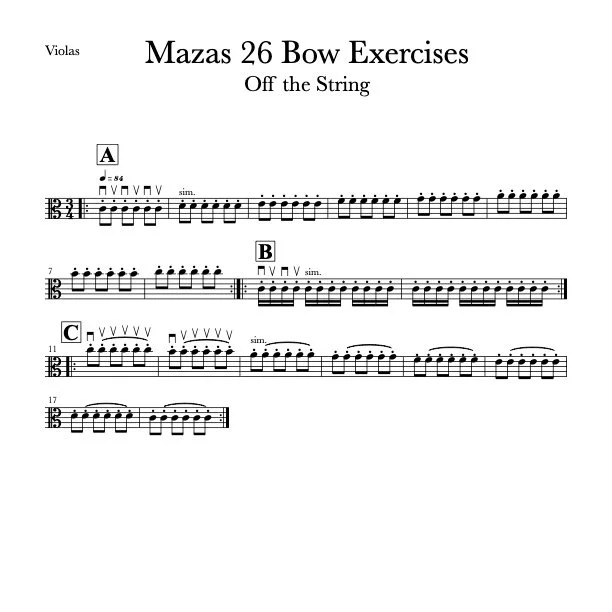IN THIS LESSON
THE OFF-THE-STRING STROKE.
A bright and clear off-the-string stroke is essential in certain passages of Mazas 26. The presence of a dot above notes indicates that we need to hear space between these notes - but we will always be coming from the string. When the music emanates energy and dance-like qualities, we opt for an equally spirited stroke—one characterized by a crisp start, fast and light bow speed, and a resonant, lively sound.
It's crucial that each note in this brisk and light bow stroke resonates long enough to fully articulate its core and intonation, contributing to a pleasant and melodic sound. Avoid playing too short, as it can compromise the clarity of intonation and overall sound quality.
A) + B) Continuous Alternating Up and Down Bows:
Exercise A and B focus on an off-the-string stroke with continuous alternating up and down bows.
Begin each stroke by placing the bow on the string before the first note to ensure a consistent start.
Visualize the bow tracing a smiley-face shape in the air.
Our fingers should be relaxed and responsive, not tense and controlling.
Remember, the stroke originates from the opening and closing of the elbow, with the wrist acting as a flexible shock absorber.
This should feel like easy perpetual motion.
C) Multiple Up Bow Notes with Minimal Bow Travel:
Exercise C focuses on playing multiple up bow notes consecutively while minimizing bow travel.
Try to make the up and down bows sound the same as each other!
Imagine grabbing the string with the bow near the balance point and releasing it in a circular motion, swiftly retaking in the air with the wrist before returning to grab the string for the next note.
This bow stroke could be compared more to playing hop-scotch than running down the street.
It is particularly effective in injecting fun, high-energy, and playful elements into the music.
-
Ellen Rose, former principal viola of the Dallas Symphony Orchestra, writes a very all-encompassing scale book which helps to build skills needed in orchestra playing, like off-the-string strokes, through scales.
